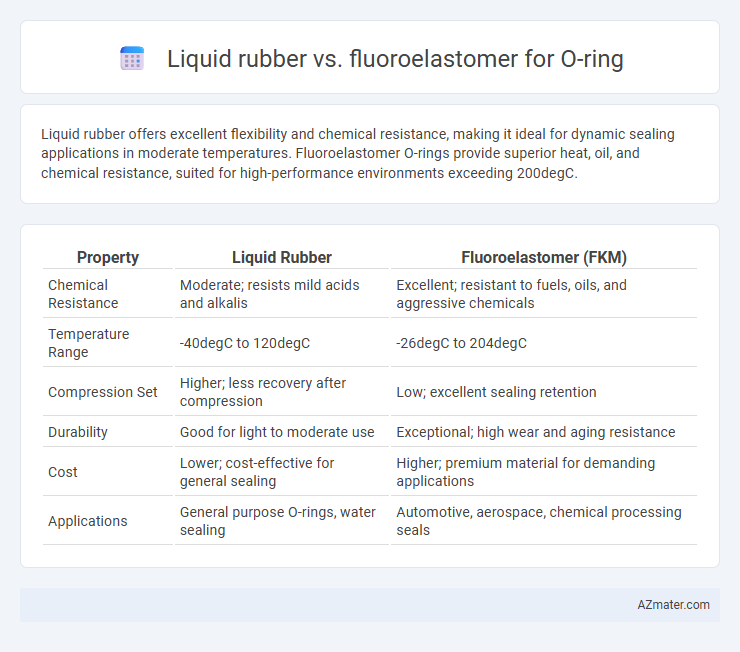Liquid rubber offers excellent flexibility and chemical resistance, making it ideal for dynamic sealing applications in moderate temperatures. Fluoroelastomer O-rings provide superior heat, oil, and chemical resistance, suited for high-performance environments exceeding 200degC.
Table of Comparison
| Property | Liquid Rubber | Fluoroelastomer (FKM) |
|---|---|---|
| Chemical Resistance | Moderate; resists mild acids and alkalis | Excellent; resistant to fuels, oils, and aggressive chemicals |
| Temperature Range | -40degC to 120degC | -26degC to 204degC |
| Compression Set | Higher; less recovery after compression | Low; excellent sealing retention |
| Durability | Good for light to moderate use | Exceptional; high wear and aging resistance |
| Cost | Lower; cost-effective for general sealing | Higher; premium material for demanding applications |
| Applications | General purpose O-rings, water sealing | Automotive, aerospace, chemical processing seals |
Introduction to O-Ring Materials
O-rings made from liquid rubber offer excellent flexibility, chemical resistance, and ease of molding, making them suitable for various sealing applications. Fluoroelastomers provide superior temperature stability, exceptional resistance to fuels, oils, and aggressive chemicals, and long-term durability in harsh environments. Choosing between liquid rubber and fluoroelastomer depends on the specific operating conditions, including temperature range, chemical exposure, and mechanical stress requirements.
What Is Liquid Rubber?
Liquid rubber is a highly flexible, sprayable or brushable polymer coating used to create seamless, waterproof seals ideal for O-rings and gaskets. It cures into a durable, elastic layer resistant to chemicals, abrasion, and extreme temperatures, offering a cost-effective alternative to traditional elastomers. Unlike fluoroelastomers, which are chemically synthesized rubber compounds with exceptional heat and chemical resistance, liquid rubber provides easier application and repair options but generally lower maximum temperature tolerance and chemical resistance.
What Is Fluoroelastomer?
Fluoroelastomer is a high-performance synthetic rubber known for its exceptional resistance to heat, chemicals, oils, and fuels, making it ideal for O-rings used in demanding industrial applications. Unlike liquid rubber, fluoroelastomer offers superior durability and dimensional stability under extreme temperatures and harsh environments. Its unique molecular structure provides outstanding sealing capabilities, ensuring long-term reliability in automotive, aerospace, and chemical processing industries.
Key Properties Comparison
Liquid rubber O-rings offer excellent flexibility, chemical resistance, and ease of application, making them suitable for dynamic sealing environments with moderate temperatures. Fluoroelastomer O-rings provide superior chemical and temperature resistance, withstanding harsh fuels, oils, and extreme heat up to 200degC, ideal for aerospace and automotive industries. Both materials excel in sealing performance, but fluoroelastomers outperform liquid rubber in long-term durability and resistance to aggressive chemicals.
Chemical Resistance: Liquid Rubber vs Fluoroelastomer
Fluoroelastomer O-rings exhibit superior chemical resistance, effectively withstanding aggressive solvents, fuels, and oils at high temperatures, making them ideal for demanding industrial applications. Liquid rubber O-rings offer good resistance to mild chemicals and water but degrade faster when exposed to harsh chemicals such as acids, alkalis, and hydrocarbon solvents. Selecting between liquid rubber and fluoroelastomer depends on the specific chemical exposure and operating environment, with fluoroelastomers providing enhanced durability against a broader range of corrosive substances.
Temperature Performance Differences
Liquid rubber O-rings typically operate effectively within a temperature range of -40degC to 120degC, making them suitable for moderate thermal conditions. Fluoroelastomer O-rings excel in high-temperature environments, withstanding continuous exposure from -26degC up to 200degC and short-term spikes as high as 230degC. The superior thermal stability of fluoroelastomers results from their strong carbon-fluorine bonds, enhancing resistance to heat, chemicals, and oxidation compared to liquid rubber alternatives.
Durability and Longevity
Liquid rubber offers flexibility and excellent resistance to abrasion, making it suitable for applications with moderate chemical exposure but typically has shorter longevity compared to fluoroelastomers. Fluoroelastomers provide superior durability against extreme temperatures, aggressive chemicals, and ultraviolet radiation, resulting in significantly extended service life for O-rings in harsh environments. The enhanced chemical and thermal stability of fluoroelastomers ensures reliable sealing performance over prolonged periods, reducing maintenance and replacement costs.
Ideal Applications for Each Material
Liquid rubber O-rings excel in applications requiring flexible sealing solutions with excellent chemical resistance and waterproofing, often used in automotive, electronics, and plumbing industries. Fluoroelastomer O-rings offer superior performance in extreme temperature ranges (-40degC to 200degC) and harsh chemical environments, making them ideal for aerospace, fuel systems, and industrial machinery. Choosing between liquid rubber and fluoroelastomer depends on the specific operational demands such as temperature tolerance, chemical exposure, and mechanical stress.
Cost Considerations
Liquid rubber O-rings typically offer a more cost-effective solution due to lower material and manufacturing expenses compared to fluoroelastomer O-rings, which involve higher production costs resulting from specialized fluorinated polymers. Fluoroelastomer O-rings provide superior chemical resistance, temperature tolerance, and durability but generally come at a premium price, often justified in high-performance or critical sealing applications. Budget constraints and application requirements heavily influence the choice between affordable liquid rubber options and the more expensive, yet robust, fluoroelastomer seals.
Choosing the Best O-Ring Material
Choosing the best O-ring material involves comparing liquid rubber and fluoroelastomer, as both offer distinct advantages. Liquid rubber excels in flexibility, ease of application, and resistance to environmental factors like moisture and UV exposure, making it ideal for general sealing applications. Fluoroelastomers provide superior chemical resistance, high-temperature stability up to 200degC, and excellent compression set resistance, making them the preferred choice for demanding industrial and automotive environments.

Infographic: Liquid rubber vs Fluoroelastomer for O-ring
 azmater.com
azmater.com